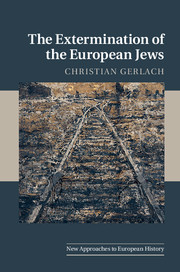Book contents
- Frontmatter
- Contents
- List of tables
- Acknowledgments
- List of abbreviations
- 1 Introduction
- Part I Persecution by Germans
- Part II Logics of persecution
- Part III The European dimension
- 12 Legislation against Jews in Europe: A comparison
- 13 Divided societies: Popular input to the persecution of Jews
- 14 Beyond legislation: Non-German policies of violence
- 15 In the labyrinths of persecution: Survival attempts
- 16 Conclusion: Group destruction in extremely violent societies
- Bibliography
- Index
16 - Conclusion: Group destruction in extremely violent societies
from Part III - The European dimension
Published online by Cambridge University Press: 05 March 2016
- Frontmatter
- Contents
- List of tables
- Acknowledgments
- List of abbreviations
- 1 Introduction
- Part I Persecution by Germans
- Part II Logics of persecution
- Part III The European dimension
- 12 Legislation against Jews in Europe: A comparison
- 13 Divided societies: Popular input to the persecution of Jews
- 14 Beyond legislation: Non-German policies of violence
- 15 In the labyrinths of persecution: Survival attempts
- 16 Conclusion: Group destruction in extremely violent societies
- Bibliography
- Index
Summary
This book puts the murder of European Jews in much broader contexts than is usual. It describes Germans’ mindsets and interests that influenced the destruction. It considers episodes of mass violence against non-Jewish groups and relates and compares them to the fate of Jews. And it takes the policies of non-German states and the behavior of other societies into account. The book's point of departure is that we should analyze modern mass violence as a multi-causal, participatory process that victimizes multiple groups. This approach is meant to uncover dynamics that are not visible when one examines the fate of one persecuted group alone, or when one only examines the history of the state and of political ideas.
As a result, this study emphasizes, more than others, the impact of popular racism (rather than scientific notions of race), nationalism and economic interests on the persecution of Jews and other groups, particularly interests in gains for the non-Jewish bourgeoisie and the educated middle class. My findings suggest that in many regards the background to persecution by Nazi Germany and other countries did not differ as much as is often portrayed. In each country (other than Germany), individual, group and what were perceived as national interests mattered more than Germany's. These national interests did not go uncontested and were sometimes the subject of public debate, as was the violence. Among Germans, these interests were much less contested since there was less social conflict within Germany than there was elsewhere. Facing persecution from forces beyond merely the state, Jews’ survival strategies were adapted to deal with the situation of being under threat also from large parts of the population.
Logics of persecution: Economy, ideology and multi-causality
The persecution of European Jews was unusual in many ways; for example, it was a transnational and international action. Yet, like other political processes, it is explainable, since it was structured by a variety of actors with identifiable attitudes and interests. The latter were more changeable than the former, although interests too could have a long-term character and impact. Explanations of the extermination of European Jews will probably always remain controversial. This book has offered elements of an explanation by exploring different logics of the persecution of Jews: racist thought, imperialistic chauvinism, counterinsurgency strategies, various economic-material factors and foreign policy goals. Although I have discussed these threads one by one, they were in reality interwoven.
- Type
- Chapter
- Information
- The Extermination of the European Jews , pp. 435 - 449Publisher: Cambridge University PressPrint publication year: 2016

